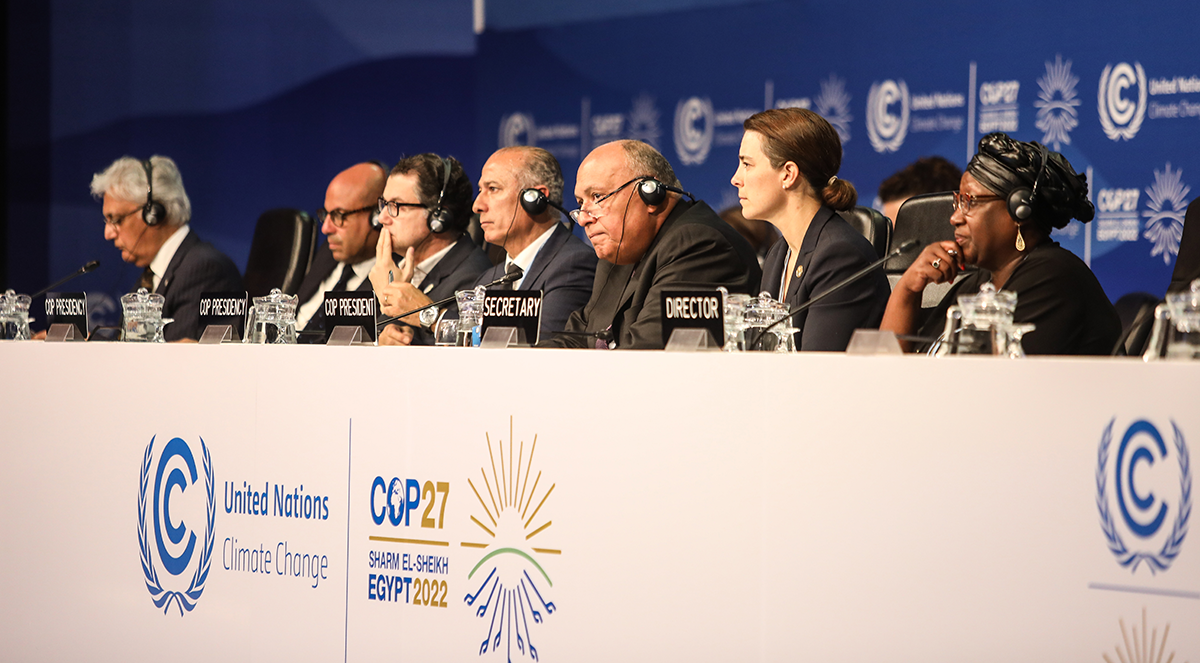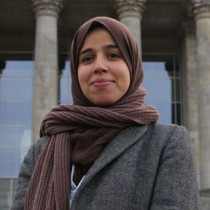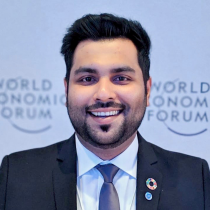

The 2022 United Nations Climate Change Conference (27th Conference of the Parties, COP27) in Sharm el-Sheikh, Egypt came to a delayed close on Nov. 20 with climate negotiations coming to agreement on the creation of a climate “loss and damage” fund, a huge victory for climate-vulnerable and developing nations. And while news of the loss and damage fund dominated the headlines, many other developments (and stalemates) took place over the course of the two-week meeting, including the release of the UAE’s new National Net Zero by 2050 Pathway, the unveiling of more information about the Saudi Green Initiative, and the signing of a Memorandum of Understanding between the UAE and Jordan on renewable energy development.
With COP27 officially concluded, we asked experts from across MEI, some of whom attended the meeting, to offer their perspectives on the developments that came out of the conference and what it means moving forward, especially for the Middle East and North Africa.
Photo by Mohamed Abdel Hamid/Anadolu Agency via Getty Images
Viewpoints
-
Malak Altaeb
Malak Altaeb

The focus now must be on tackling today’s issues
COP27 was under intense international scrutiny given the soaring expectations, especially in the MENA region, that the meeting’s focus would be on implementation. The conference in Sharm el-Sheikh offered an opportunity to focus on the importance of achieving climate justice, and ultimately, countries agreed to create a loss and damage fund. This is truly a major step forward for developing countries’ ability to tackle the economic and ecological impacts of climate change as well as support the vulnerable communities most affected by climate change-induced extreme weather events, like those experienced by much of the region this year. However, outlining a concrete mechanism for this fund will be crucial to ensure that those affected will receive actual assistance and to reduce delays in meeting funding pledges and commitments.
To effectively move forward from COP27, the governments of the MENA region must focus on enhancing their climate action plans and bridging the existing gap in implementing sustainable solutions involving, especially, small-scale projects directly linked to people's daily lives, work, and environment. Specifically, this means addressing stressed water infrastructure, pursuing nature-based solutions, and supporting local agriculture to enhance food security.
In the post-COP27 world, MENA nations must shift from focusing on future scenarios and pledges to tackling today’s issues and activating climate action in different sectors by addressing social inequalities and generating opportunities for investments in economic development.
Climate change is not only a domestic issue for MENA countries. Its growing impact transcends borders, making regional cooperation all that much more important. In the MENA region, the most important priorities best tackled in a regional format include accelerating the energy transition, technological advancements, and financial innovation in water and food governance and management. The steps taken in the wake of COP27 will be vital for ensuring credibility as we look forward to COP28, which the UAE will host next year.
Malak Altaeb is a non-resident scholar with MEI’s Climate and Water Program and an independent consultant, writer, and researcher based in Paris, France.
-
Andrei Covatariu
Andrei Covatariu

One step forward, one step back
While the adoption of the first global loss and damage framework — 15 years after it was first mentioned at a COP gathering — is a major milestone and a significant first step in compensating for historical discrepancies, arguably little to no progress was made at COP27 in Sharm el-Sheikh.
In fact, on the energy front, one could even describe COP27 as a moment of climate regression. The conclusions document “emphasizes the urgent need for immediate, deep, rapid and sustained reductions in global greenhouse gas emissions […] including through increase in low-emission and renewable energy.” Considering this year’s security of supply struggles, especially in Europe, ensuring flexibility for low-emissions generation — namely gas — is necessary, while also giving developing countries an opportunity for economic growth using domestic resources. Nevertheless, the current statement is a significant step backward when it comes to the Paris goals.
As the years go by, the gap between climate objectives and reality is widening, with no credible scenarios to limit global warming to less than 1.5°C. This increases costs for mitigation measures, but even more so for adaptation actions, as climate effects are making everyday news around the world. While these considerations are prioritized differently from one region to another, governments are mainly focusing their time and budgets on continuous, overlapping crises — the pandemic, war, inflation, rising energy prices, global food supply challenges — leaving limited capacity to address climate change and its repercussions. However, different outcomes ought to emerge, at least from a COP event. The current energy crisis has actually made Europe more determined to take bolder and more pragmatic actions (at least on paper, for the moment) on climate change than most recent COP events. After all, pain does make decision-makers move.
Andrei Covatariu is an international energy and climate change expert and a Non-Resident Scholar with the Climate and Water Program at the Middle East Institute.
-
Neeshad Shafi
Neeshad Shafi

Huge strides on loss and damage and for youth, but limited impact on the ground
COP27 was potentially the largest summit in COP history. According to the U.N. Framework Convention on Climate Change (UNFCCC), a total of 49,704 people attended, meaning it surpassed COP26 by more than 10,000 participants. COP27 also made history on two other key fronts: developing countries secured a new fund to support the victims of climate disasters and, for the first time ever, children and youth had both an official space and an official youth envoy. From small protests to meetings and panels to public events, young people’s voices seemed more prominent than ever. Behind the scenes, however, they feel that governments and big companies are using them to look good without really listening to what they have to say.
This year’s so-called African COP was both chaotic and expensive. While some may see it as a success and others as a failure, it isn’t easy to say, given the mixed results. COP27 closed with a breakthrough agreement, laid out in the Sharm el-Sheikh Implementation Plan released at dawn on Nov. 20, to provide loss and damage funding for vulnerable countries hit hard by climate disasters. But the conference failed to deliver what science tells us needs to be done. The call to "keep 1.5 alive" hangs in the balance and is still on "life support." COP27 also did far too little to address the issue of mitigation — that is, cutting fossil fuel emissions. There is no doubt that the planet has already warmed. The debate over how countries will reduce their emissions continues, with some negotiators expressing concern that the 1.5°C target may be at risk.
COP27 made history by ensuring that the voices of the young were heard; indeed, it was one of the key areas of focus for the COP27 Presidency. "Youth stand to be the most impacted by the decisions we take at the climate process. Thus, they should be considered a natural ally and partner in driving climate action," said COP27 President Sameh Shoukry, Egypt’s foreign minister.
The Children and Youth Pavilion at COP27 became a one-stop hub for “youth washing” for global leaders and celebrities alike. While the pavilion held informal gatherings and discussions, it also kept youth far away from the actual negotiation tables, which were located in the “Blue Zone.” Youth leaders from the Global South called for an end to this “youth tokenism,” pushing instead to be recognized as partners in fight against climate change and directly involved in official negotiations. Far from valuing their unique perspective, most young experts believe they are simply being treated as a box-ticking exercise.
Young people from Africa and the Arab world remain skeptical of international climate conferences because they are routinely frustrated by political leaders’ unfulfilled promises and the lack of urgent action needed to tackle the climate emergency. This year the U.N. climate summit was held in Africa, where 70% of the population is under the age of 30 — an even greater share than in the Middle East (55%) — and vulnerable communities are on the frontlines of the climate crisis. This underscores the importance of listening to the voices of young people from Africa and the Middle East at COP27, but once again youth from the Global North dominated in terms of panel invitations, speeches, and applause and recognition. Snapshots from social media saw prominent “celebrity” youth activist go from one event to the next with little rest. Some even had to cancel appearances after the packed schedule left them exhausted. Youth from the Global South, by contrast, had limited voice, even as many young activists from Africa and the Arab world pushed for a seat at the negotiation table so they could express their concerns and aspirations.
What we need is an intersectional approach to addressing the climate crisis. It is essential that the voices of different youth groups be heard, especially marginalized groups from Africa and the Arab world that have been disproportionately affected by the impacts of climate change. The Intergovernmental Panel on Climate Change’s latest report made it clear that we are now in extraordinarily dangerous territory. Those that will inherit this danger are the youth, children, and those who have yet to be born.
Neeshad Shafi is an environmentalist and policy-oriented climate change advocate, as well as a non-resident scholar with MEI’s Climate and Water Program.
-
Athra Khamis
Athra Khamis

Setting the tone for the Middle East
While the so-called African Climate Change Conference saw the announcement of the establishment of a loss and damage fund, according to many it wasn’t really an African COP when it came to many of the other agenda items that it promised to resolve, especially the issue of mitigation, or when considering developing countries in the logistics and facilitation of climate policies.
COP27 has also been called “the COP of implementation,” a phrase the COP27 Presidency insisted on using at the very end of the conference when flagging the historic decision to establish a loss and damage fund as well as to promote inclusive transitions to low-emission and climate-resilient development under the Sharm el-Sheikh Implementation Plan, in line with the Convention, Kyoto Protocol, Paris Agreement, and Glasgow Climate Pact.
These historic outcomes were not the only victories at COP27, however. Middle Eastern countries had their own share of wins as well, making positive progress and continuing ongoing green developments in responding to climate change. Countries in the Middle East, and specifically the Gulf, have proven their growing commitment to climate action by advancing national pathways, international partnerships, and collaborative efforts.
The UAE had a breakthrough announcement of the kick-off of its “Net Zero by 2050 Pathway” to comply with the strategic initiative it launched at Expo 2020 in Dubai and its revised Nationally Determined Contribution published after COP26 in Glasgow. This introduced a “diversified pathway” for the UAE to follow to meet the Paris Agreement target of keeping global warming below 2°C, accelerating the shift toward a green economy, while ensuring a balance between climatic and socio-economic impacts. It is also worth noting that, in just a one-year period, the UAE has formed a new National Committee for the Development of the National Strategy for Net Zero by 2050, which has successfully set a timeframe and identified mechanisms to implement the country’s Net Zero by 2050 Strategic Initiative.
Benchmarking such initiatives by Middle Eastern countries at COPs and other international conferences not only showcases their capacity-building efforts but also truly empowers developing countries to fight against climate change and its implications as well as accelerates global momentum toward the target to be achieved.
Although COP27 did not crystallize many agenda items and most of them have been shifted back to COP28 in the UAE, the 2022 U.N. Climate Change Conference did set the tone for Middle Eastern countries when it comes to their contributions and progress in taking action on the Paris Agreement requirements — and in many cases they have advanced further than the heretofore dominant developed countries in the West. Most importantly, it has brought attention to and strengthened the pillar of adaptation and mitigation in Africa and the Middle East, prompting all nations to consider and heavily focus on addressing these key issues for the sake of the global good.
Athra Khamis is a Non-Resident Scholar with the Climate and Water Program at the Middle East Institute.
-
Mirette F. Mabrouk
Mirette F. Mabrouk

Progress and frustration at COP27
Depending on whom you were speaking with, the results of COP27 were cause for either celebration or commiseration. In both cases, the results clearly illustrated the influence of economic politics and lobbying on globally relevant outcomes.
The conference proceedings finally made it over the finish line after a mammoth weekend-long session that saw rising tensions and frustrations. There was one considerable, historic win. The year had seen unabated lobbying by the G77 group of developing nations for a fund for loss and damage. The catastrophic floods in Pakistan lent a specific urgency to the demand, and to Pakistan’s decisive role in the proceedings. By the beginning of the conference, Egypt, as president of COP27, managed to get loss and damage on the agenda — a measure that had been stymied by developed nations for almost three decades. When the conference wrapped, it was with a historic decision to establish and operationalize a fund for nations most vulnerable to climate change.
The decision comes with serious provisos, however: It may be years before there is any actual money on the table and the definition of “most vulnerable” will need to be decided by committee since, technically speaking, countries like the oil-rich states of the Gulf and China are termed “developing nations.” But it is nonetheless a significant win for those developing nations that have been bearing the brunt of climate change, despite it having been caused overwhelmingly by developed ones. After producing emissions at a rapid pace since the late 18th century, developed nations have attempted to shirk the financial responsibility of helping developing ones deal with the consequences. To add insult to injury, there has been a concerted drive to attempt to tie developing nations into a path towards net-zero emissions, regardless of their minimal contribution to global emissions, or the technical challenges or costs involved.
While the establishment of the fund was hailed as a huge victory, there was also widespread frustration at the lack of any progress on reducing emissions and the use of fossil fuels, otherwise known as “mitigation.” The wording of the agreement called for "efforts towards the phasedown of unabated coal power and phase-out of inefficient fossil fuel subsidies." Efforts to phase out, or even phase down, fossil fuels, were stymied. This was hardly surprising considering the presence and power of fossil fuel producing and consuming nations. Matters were not helped by the global energy crunch caused by the war in Ukraine or the presence of 636 energy industry lobbyists at the conference — up 25% from the year before. It was a clear illustration of the dangers of expecting nations to sideline their domestic needs over global ones.
Mirette F. Mabrouk is an MEI senior fellow and director of the Institute's Egypt Studies program.











